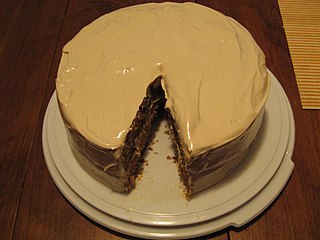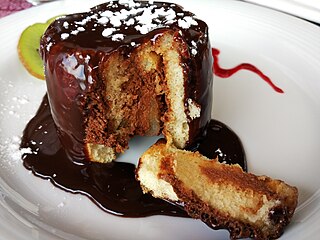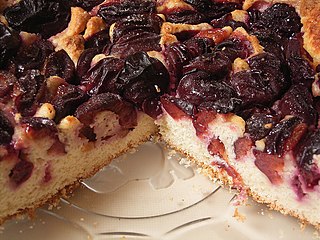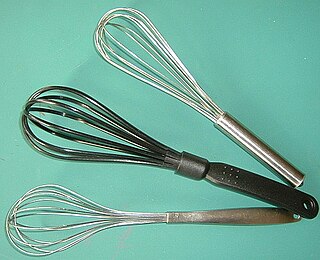Related Research Articles

Confectionery is the art of making confections, or sweet foods. Confections are items that are rich in sugar and carbohydrates although exact definitions are difficult. In general, however, confections are divided into two broad and somewhat overlapping categories: bakers' confections and sugar confections.

Cake is a flour confection made from flour, sugar, and other ingredients and is usually baked. In their oldest forms, cakes were modifications of bread, but cakes now cover a wide range of preparations that can be simple or elaborate and which share features with desserts such as pastries, meringues, custards, and pies.

A bride is a woman who is about to be married or who is a newlywed.
You can't have your cake and eat it (too) is a popular English idiomatic proverb or figure of speech. The proverb literally means "you cannot simultaneously retain possession of a cake and eat it, too". Once the cake is eaten, it is gone. It can be used to say that one cannot have two incompatible things, or that one should not try to have more than is reasonable. The proverb's meaning is similar to the phrases "you can't have it both ways" and "you can't have the best of both worlds."

A bun is a type of bread roll, typically filled with savory fillings. A bun may also refer to a sweet cake in certain parts of the world. Though they come in many shapes and sizes, buns are most commonly round, and are generally hand-sized or smaller.

Dough is a thick, malleable, sometimes elastic paste made from grains or from leguminous or chestnut crops. Dough is typically made by mixing flour with a small amount of water or other liquid and sometimes includes yeast or other leavening agents, as well as ingredients such as fats or flavourings.

A flamen was a priest of the ancient Roman religion who was assigned to one of fifteen deities with official cults during the Roman Republic. The most important of these were the three flamines maiores, who served the important Roman gods Jupiter, Mars, and Quirinus. The remaining twelve were the flamines minores. Two of the minores served deities whose names are now unknown; among the others are deities about whom little is known other than the name. During the Imperial era, the cult of a deified emperor also had a flamen.

Shortbread or shortie is a traditional Scottish biscuit usually made from one part white sugar, two parts butter and three to four parts plain wheat flour. Shortbread does not contain any leavening, such as baking powder or baking soda. Shortbread is widely associated with Christmas and Hogmanay festivities in Scotland, and some Scottish brands are exported around the world.
In ancient Rome, confarreatio was a traditional patrician form of marriage. The ceremony involved the bride and bridegroom sharing a cake of emmer, in Latin far or panis farreus, hence the rite's name. The Flamen Dialis and pontifex maximus presided over the wedding, and ten witnesses had to be present. The woman passed directly from the hand (manus) of her father or head of household to that of her new husband.

Simnel cake is a fruitcake associated with Lent and Easter and widely eaten in England, Ireland and countries with patterns of migration from them. It is distinguished by layers of almond paste or marzipan, typically one in the middle and one on top, and a set of eleven balls made of the same paste. It was originally made for the fourth Sunday in Lent, also known as Laetare Sunday, the Refreshment Sunday of Lent, Mothering Sunday, the Sunday of the Five Loaves, or Simnel Sunday; named after the cake. In the United Kingdom, it is now commonly associated with Mothering Sunday and Easter Sunday.

Spice cake is a type of cake that is traditionally flavored with a mixture of spices. The cake can be prepared in many varieties. Predominant flavorings include spices such as cinnamon, cloves, allspice, ginger, and nutmeg.

A génoise, also known as Genoese cake or Genovese cake, is a French sponge cake named after the city of Genoa and associated with French cuisine. It was created by François Massialot in the late 17th century. Instead of using chemical leavening, air is suspended in the batter during mixing to provide volume.

Battenberg or Battenburgcake is a light sponge cake with variously coloured sections held together with jam and covered in marzipan. In cross section, the cake has a distinctive pink and yellow check pattern. It originated in England.

Frangipane is a sweet almond-flavoured custard, typical in French pastry, used in a variety of ways, including cakes and such pastries as the Bakewell tart, conversation tart, Jésuite and pithivier. A French spelling from a 1674 cookbook is franchipane, with the earliest modern spelling coming from a 1732 confectioners' dictionary. Originally designated as a custard tart flavoured by almonds or pistachios, it came later to designate a filling that could be used in a variety of confections and baked goods.

A charlotte is a type of bread pudding that can be served hot or cold. It is also referred to as an "icebox cake". Bread, sponge cake, crumbs or biscuits/cookies are used to line a mold, which is then filled with a fruit puree or custard. The baked pudding could then be sprinkled with powdered sugar and glazed with a salamander, a red-hot iron plate attached to a long handle, though modern recipes would likely use more practical tools to achieve a similar effect.

Manus was an Ancient Roman type of marriage, of which there were two forms: cum manu and sine manu. In a cum manu marriage, the wife was placed under the legal control of the husband. In a sine manu marriage, the wife remained under the legal control of her father.

Elizabeth Raffald was an English author, innovator and entrepreneur.

Plum cake refers to a wide range of cakes usually made with dried fruits such as currants, raisins, sultanas, or prunes, and also sometimes with fresh fruits. There is a wide range of popular plum cakes and puddings. Since the meaning of the word "plum" has changed over time, many items referred to as plum cakes and popular in England since at least the eighteenth century have now become known as fruitcake. The English variety of plum cake also exists on the European mainland, but may vary in ingredients and consistency. British colonists and missionaries brought the dried fruit variety of cake with them, for example, in British India where it was served around the time of the Christmas holiday season. In America's Thirteen Colonies, where it became associated with elections, one version came to be called election cake.

A whisk is a cooking utensil which can be used to blend ingredients smooth or to incorporate air into a mixture, in a process known as whisking or whipping. Most whisks consist of a long, narrow handle with a series of wire loops joined at the end. The loops can have different shapes depending on a whisk's intended functions. The wires are usually metal, but some are plastic for use with nonstick cookware. Whisks are also made from bamboo.

Palatschinke is a thin crêpe-like variety of pancake of Greco-Roman origin. The dessert is common in the Balkans, Central and Eastern Europe.
References
- ↑ "diffarreation" . Oxford English Dictionary (Online ed.). Oxford University Press.(Subscription or participating institution membership required.)
- ↑
 This article incorporates text from a publication now in the public domain : Chambers, Ephraim, ed. (1728). "Diffarreation". Cyclopædia, or an Universal Dictionary of Arts and Sciences (1st ed.). James and John Knapton, et al.
This article incorporates text from a publication now in the public domain : Chambers, Ephraim, ed. (1728). "Diffarreation". Cyclopædia, or an Universal Dictionary of Arts and Sciences (1st ed.). James and John Knapton, et al.